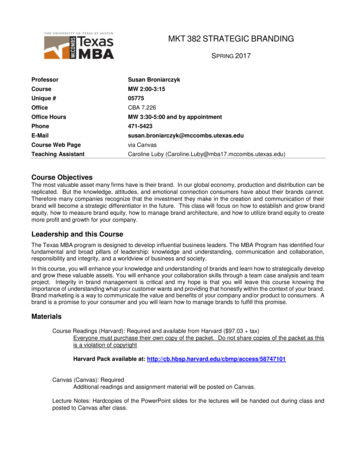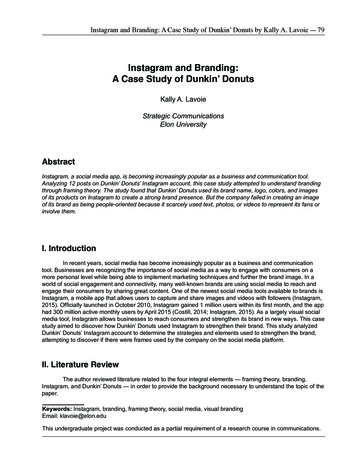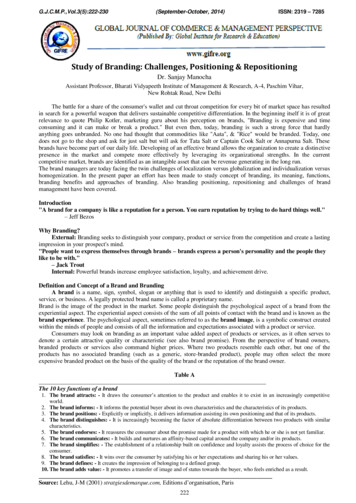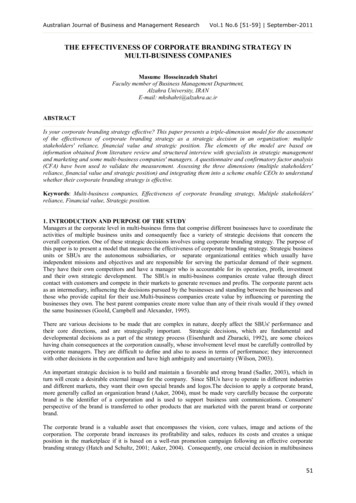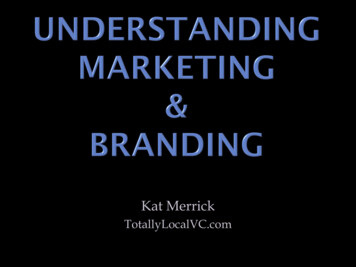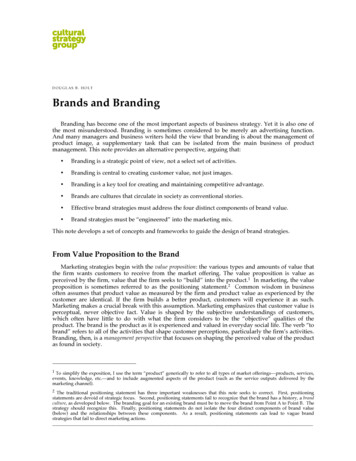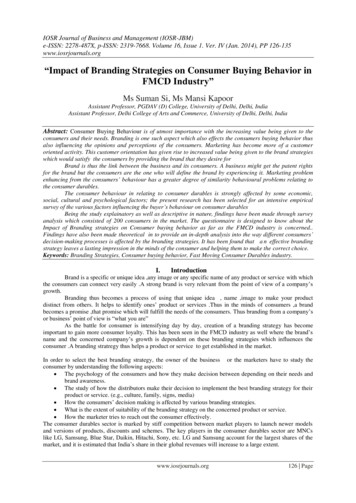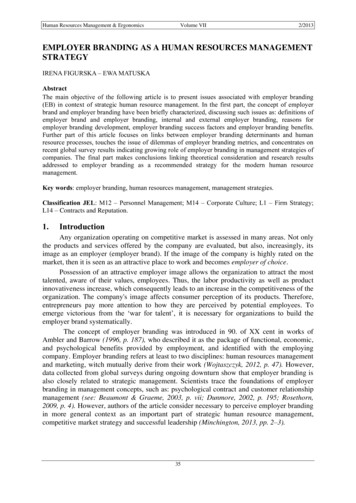
Transcription
Human Resources Management & ErgonomicsVolume VII2/2013EMPLOYER BRANDING AS A HUMAN RESOURCES MANAGEMENTSTRATEGYIRENA FIGURSKA – EWA MATUSKAAbstractThe main objective of the following article is to present issues associated with employer branding(EB) in context of strategic human resource management. In the first part, the concept of employerbrand and employer branding have been briefly characterized, discussing such issues as: definitions ofemployer brand and employer branding, internal and external employer branding, reasons foremployer branding development, employer branding success factors and employer branding benefits.Further part of this article focuses on links between employer branding determinants and humanresource processes, touches the issue of dilemmas of employer branding metrics, and concentrates onrecent global survey results indicating growing role of employer branding in management strategies ofcompanies. The final part makes conclusions linking theoretical consideration and research resultsaddressed to employer branding as a recommended strategy for the modern human resourcemanagement.Key words: employer branding, human resources management, management strategies.Classification JEL: M12 – Personnel Management; M14 – Corporate Culture; L1 – Firm Strategy;L14 – Contracts and Reputation.1.IntroductionAny organization operating on competitive market is assessed in many areas. Not onlythe products and services offered by the company are evaluated, but also, increasingly, itsimage as an employer (employer brand). If the image of the company is highly rated on themarket, then it is seen as an attractive place to work and becomes employer of choice.Possession of an attractive employer image allows the organization to attract the mosttalented, aware of their values, employees. Thus, the labor productivity as well as productinnovativeness increase, which consequently leads to an increase in the competitiveness of theorganization. The company's image affects consumer perception of its products. Therefore,entrepreneurs pay more attention to how they are perceived by potential employees. Toemerge victorious from the ‘war for talent’, it is necessary for organizations to build theemployer brand systematically.The concept of employer branding was introduced in 90. of XX cent in works ofAmbler and Barrow (1996, p. 187), who described it as the package of functional, economic,and psychological benefits provided by employment, and identified with the employingcompany. Employer branding refers at least to two disciplines: human resources managementand marketing, witch mutually derive from their work (Wojtaszczyk, 2012, p. 47). However,data collected from global surveys during ongoing downturn show that employer branding isalso closely related to strategic management. Scientists trace the foundations of employerbranding in management concepts, such as: psychological contract and customer relationshipmanagement (see: Beaumont & Graeme, 2003, p. vii; Dunmore, 2002, p. 195; Rosethorn,2009, p. 4). However, authors of the article consider necessary to perceive employer brandingin more general context as an important part of strategic human resource management,competitive market strategy and successful leadership (Minchington, 2013, pp. 2–3).35
Human Resources Management & Ergonomics2.Volume VII2/2013The essence of employer brandUntil recently, the employees remained in relative inferiority in respect to employers.Nowadays, these relations are changing. If a company wants to be competitive on the market,it must fight for the best specialists – for talents. It is especially in the interest of thosecompanies that base their businesses on the competences of their employees. One of the formsof struggle for talent in today's labor markets is employer branding, that is building a brand ofan employer of choice. It can be assumed that the more expressive, better employer brand theorganization possess, the more attractive place to work for employees it is. The questionarises, what does the employer brand mean?One can find many definitions of employer brand in the literature. According to variousauthors, employer brand is:- “( ) the two-way deal between an organization and its people – the reason theychoose to join and the reasons they choose – and are permitted – to stay,”(Rosethorn, 2009);- “( ) a set of attributes that make an organization distinctive and attractive to thosepeople who will feel an affinity with it and deliver their best performance withinit,” (CIPD, 2006);- “( ) the image of the organization as a great place to work in the minds of currentemployees and key stakeholders in the external market (active and passivecandidates, clients, customers and other key stakeholders),” (SHRM, 2008);- A complex concept based on various intangible factors, including perception,image versus identity, and the ability to differentiate between them (Randstad,http://www.randstadaward.ca);- A sum of the key qualities current and prospective employees identify withorganization as an employer, such as: economic (compensation and benefits),functional (e.g. learning new skills) or psychological (e.g. sense of identity andstatus), (Mosley, 2009, p. 4).Any organization that wants to build its competitiveness in the market consciously,should also build its brand of employer of choice. Employer brand of specific organization isdetermined by such factors as: attractiveness of the sector, company’s reputation, quality ofproducts and service, location, work environment, pay, economic conditions, employeebenefits, people and culture, work/life balance and corporate social responsibility(www.kellyservices.com.my).Employer brand of the company is not built from scratch, because it already – somehowspontaneously – exists as a result of the use (or not use) of some strategy. If the companydoesn’t shape its image consciously, it has no influence on how it is perceived as anemployer, and affects the customers only through the quality of its products (Berłowski &Turłukowska, http://www.kadry.abc.com.pl).3.The essence of employer brandingThe process of intentional development of the employer brand is called employerbranding. In the literature employer branding is defined as:- Development and communication of an organization's culture as an employer in themarketplace. It is the package of functional, economic and psychological benefitsprovided by employment and identified with the employing company (Ambler &Barrow, 1996);36
Human Resources Management & ErgonomicsVolume VII2/2013-A targeted long term strategy to manage awareness and perceptions of employees,potential employees and related stakeholders with regards to a particular firm(Sullivan, 2004);- A process of building an identifiable and unique identity of the employer(Backhous & Tikoo, 2004);- The efforts of the organization in communicating internal and external stakeholdersof what makes it both desirable and distinctive employer (Jenner & Taylor, 2008,p. 7);- Attracting talented people to the organization and ensuring that both existing andpotential employees will identify with the company (its brand, mission) and deliverthe desired by the company results (Martin, 2008, p. 19);- An agreement under which the offer of the employer (manifested in organizationalgoals, values and initiatives that build trust in the employees) and counteroffer fromemployees (in the form of a high level of engagement and low retention) arematched (Matin and others, 2005, p. 78).The analysis of the definitions listed above shows that they have some elements incommon, such as: target groups, objectives of employer branding and communiquétransmitted in the process of shaping the brand of the employer.The starting point for employer branding is the identity of the organization. Accordingto M. Hatch and M. Schultz identity of the organization “( ) refers broadly to what membersperceive, feel and think about their organizations. It is assumed to be a collective, commonlyshared understanding of the organization’s distinctive values and characteristics,” (Hatch &Schultz, 2007, p. 327). It is also defined as a symbolic, collective interpretation of employees,referring to what the organization is and what it wants to be. The identity of the organizationrequires identification with the company and internalization (adoption and assimilation oforganizational values), (Sułkowski, 2005, pp. 7–8, 24–25).In pursuit of the perfect identity, the organization communicates with individuals andentities inside and outside the organization. The effect of identity’s communication and itsperception is the image of the organization, which with the time is recorded and takes theform of reputation (Sitko & Zarębska, 2007, p. 82). Employer branding requires takingactions consistent with the identity of the organization.Depending on to whom initiatives in the field of employer branding are addressed, EBis divided into internal and external (http://www.bigram.pl). Internal employer branding isaddressed primarily to existing and leaving employees and is implemented by means ofdevelopment programs and building a well-defined corporate culture. External employerbranding is addressed to active professionals, students, graduates and other stakeholders andis implemented by means of effective use of modern communication channels, relations withthe academic community, co-operation with opinion-leading media, image-enhancingrecruitment projects etc.The main objective of EB is to build the image of the organization which: cares aboutthe interests and needs of their employees, invests in their professional development, as wellas observes and responds to trends emerging on the labor market.4.Reasons for the development of employer brandingIt is worth noting some key global trends that determine the need to build employerbrand. First of all, it should be emphasized that nowadays organizations operate in theenvironment which is constantly and often unpredictably changing. Changes occurring in:economy, organizational processes and procedures, customer requirements etc., mean that37
Human Resources Management & ErgonomicsVolume VII2/2013employers who will be able to manage changes, have the opportunity to achieve a competitiveadvantage in the market.Referring to the environment of the organization, essential for the development of theconcept of employer branding are: demographic changes, transformations in the structure ofhuman resources’ competences and changes in attitudes towards work. Decreasing workingage population, different perceptions of the role of work in human life by young generationand lasting for years war for talents make the difficulties in recruiting and retaining the rightemployees in organizations (Wojtaszczyk, 2012, p. 13).Another factor that determines the need for taking actions in the area of employerbranding is globalization. First of all, companies more and more frequently realize theirbusinesses on the transnational level. Secondly, advanced information and communicationtechnologies mean that it is actually impossible to build employer brand in one market or in aselected region.Next determinant of employer branding is competitiveness. Nowadays, more and moreemployers attach great importance to talent management, based on the assumption that it is aprerequisite for building a competitive organization in the long term. In particular this appliesto those organizations for which attracting and retaining talented employees can’t be easy.Therefore, many employers adopt employer branding policies in order to secure long-termneeds of talented employees.Transparency is another factor influencing the necessity of building employer brandingprograms in organizations. Nowadays employees have the possibility to share their opinionswith a wide range of people through online channels. Therefore the information transfers tothe labor market by the employer must be authentic and transparent, as it will be verified bycurrent and former employees.5.How to build employer brand?K. Backhaus and S. Tikoo assume that employer branding is a three-step process(Backhous & Tikoo, 2004, pp. 502–503):a)Creation of an employer brand representing a specific employee value proposition,which is to communicate what the organization has to offer to employees.b)External marketing of employer brand – the company directs the message to the labormarket – for candidates, recruitment agencies and other target groups.c)Internal marketing – its aim is to develop human resources, which will adhere to thevalues and pursue the objectives set by the organization.Analysis of the literature on employer branding allows distinguish the following steps inthe process of building employer brand:- Characterize current employer brand describing, how the company is perceived andexperienced by employees, candidates for the job and other stakeholders;- Characterize the vision of employer brand describing, how the company would liketo be perceived and experienced by employees, candidates for the job and otherstakeholders;- Determine the gap between actual and desired employer brand;- Work out the plan of eliminating the gap between the current brand reality andbrand vision;- Take actions aimed at eliminating the gap between actual and desired employerbrand;- Control the results of undertaken actions;- Change the plan of eliminating the gap if necessary.38
Human Resources Management & ErgonomicsVolume VII2/2013To describe current and desired employer brand, needs and aspirations of employees,candidates for a job in the organization as well as other stakeholders should be recognized.For this purpose leading employers often make use of a wide variety of qualitative andquantitative research techniques, including (Mosley, 2009, p. 8):a)Labor market mapping – where can the organization best find and target potentialcandidates.b)Attraction analysis – what are people looking for from potential employers.c)Ex
recent global survey results indicating growing role of employer branding in management strategies of companies. The final part makes conclusions linking theoretical consideration and research results addressed to employer branding as a recommended strategy for the modern human resource management. Key words: employer branding, human resources management, management strategies


